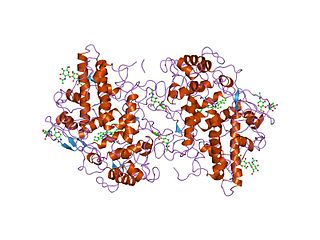Related Research Articles
Antioxidants are compounds that inhibit oxidation, a chemical reaction that can produce free radicals. Autoxidation leads to degradation of organic compounds, including living matter. Antioxidants are frequently added to industrial products, such as polymers, fuels, and lubricants, to extend their usable lifetimes. Food are also treated with antioxidants to forestall spoilage, in particular the rancidification of oils and fats. In cells, antioxidants such as glutathione, mycothiol or bacillithiol, and enzyme systems like superoxide dismutase, can prevent damage from oxidative stress.
High-density lipoprotein (HDL) is one of the five major groups of lipoproteins. Lipoproteins are complex particles composed of multiple proteins which transport all fat molecules (lipids) around the body within the water outside cells. They are typically composed of 80–100 proteins per particle. HDL particles enlarge while circulating in the blood, aggregating more fat molecules and transporting up to hundreds of fat molecules per particle.

Low-density lipoprotein (LDL) is one of the five major groups of lipoprotein that transport all fat molecules around the body in extracellular water. These groups, from least dense to most dense, are chylomicrons, very low-density lipoprotein (VLDL), intermediate-density lipoprotein (IDL), low-density lipoprotein (LDL) and high-density lipoprotein (HDL). LDL delivers fat molecules to cells. LDL is involved in atherosclerosis, a process in which it is oxidized within the walls of arteries.

Atherosclerosis is a pattern of the disease arteriosclerosis, characterized by development of abnormalities called lesions in walls of arteries. These lesions may lead to narrowing of the arteries' walls due to buildup of atheromatous plaques. At onset there are usually no symptoms, but if they develop, symptoms generally begin around middle age. In severe cases, it can result in coronary artery disease, stroke, peripheral artery disease, or kidney disorders, depending on which body parts(s) the affected arteries are located in the body.

A lipoprotein is a biochemical assembly whose primary function is to transport hydrophobic lipid molecules in water, as in blood plasma or other extracellular fluids. They consist of a triglyceride and cholesterol center, surrounded by a phospholipid outer shell, with the hydrophilic portions oriented outward toward the surrounding water and lipophilic portions oriented inward toward the lipid center. A special kind of protein, called apolipoprotein, is embedded in the outer shell, both stabilising the complex and giving it a functional identity that determines its role.

Heme, or haem, is a precursor to hemoglobin, which is necessary to bind oxygen in the bloodstream. Heme is biosynthesized in both the bone marrow and the liver.

Hypochlorous acid is an acid that forms when chlorine dissolves in water, and itself partially dissociates, forming hypochlorite, ClO−. HClO and ClO− are oxidizers, and the primary disinfection agents of chlorine solutions. HClO cannot be isolated from these solutions due to rapid equilibration with its precursor, chlorine.

Myeloperoxidase (MPO) is a peroxidase enzyme that in humans is encoded by the MPO gene on chromosome 17. MPO is most abundantly expressed in neutrophil granulocytes, and produces hypohalous acids to carry out their antimicrobial activity, including hypochlorous acid, the sodium salt of which is the chemical in bleach. It is a lysosomal protein stored in azurophilic granules of the neutrophil and released into the extracellular space during degranulation. Neutrophil myeloperoxidase has a heme pigment, which causes its green color in secretions rich in neutrophils, such as mucus and sputum. The green color contributed to its outdated name verdoperoxidase.
Respiratory burst is the rapid release of the reactive oxygen species (ROS), superoxide anion and hydrogen peroxide, from different cell types.
NADPH oxidase is a membrane-bound enzyme complex that faces the extracellular space. It can be found in the plasma membrane as well as in the membranes of phagosomes used by neutrophil white blood cells to engulf microorganisms. Human isoforms of the catalytic component of the complex include NOX1, NOX2, NOX3, NOX4, NOX5, DUOX1, and DUOX2.

Oxidative stress reflects an imbalance between the systemic manifestation of reactive oxygen species and a biological system's ability to readily detoxify the reactive intermediates or to repair the resulting damage. Disturbances in the normal redox state of cells can cause toxic effects through the production of peroxides and free radicals that damage all components of the cell, including proteins, lipids, and DNA. Oxidative stress from oxidative metabolism causes base damage, as well as strand breaks in DNA. Base damage is mostly indirect and caused by the reactive oxygen species generated, e.g., O2− (superoxide radical), OH (hydroxyl radical) and H2O2 (hydrogen peroxide). Further, some reactive oxidative species act as cellular messengers in redox signaling. Thus, oxidative stress can cause disruptions in normal mechanisms of cellular signaling.

HMOX1 is a human gene that encodes for the enzyme heme oxygenase 1. Heme oxygenase mediates the first step of heme catabolism, it cleaves heme to form biliverdin.

Heme oxygenase, or haem oxygenase, is an enzyme that catalyzes the degradation of heme to produce biliverdin, ferrous ion, and carbon monoxide.

Biliverdin reductase (BVR) is an enzyme found in all tissues under normal conditions, but especially in reticulo-macrophages of the liver and spleen. BVR facilitates the conversion of biliverdin to bilirubin via the reduction of a double-bond between the second and third pyrrole ring into a single-bond.

Foam cells, also called lipid-laden macrophages, are a type of cell that contain cholesterol. These can form a plaque that can lead to atherosclerosis and trigger myocardial infarction and stroke.

Nuclear factor erythroid 2-related factor 2 (NRF2), also known as nuclear factor erythroid-derived 2-like 2, is a transcription factor that in humans is encoded by the NFE2L2 gene. NRF2 is a basic leucine zipper (bZIP) protein that may regulate the expression of antioxidant proteins that protect against oxidative damage triggered by injury and inflammation, according to preliminary research. In vitro, NRF2 binds to antioxidant response elements (AREs) in the promoter regions of genes encoding cytoprotective proteins. NRF2 induces the expression of heme oxygenase 1 in vitro leading to an increase in phase II enzymes. NRF2 also inhibits the NLRP3 inflammasome.

Paraoxonases are a family of mammalian enzymes with aryldialkylphosphatase activity. There are three paraoxonase isozymes, which were originally discovered for their involvement in the hydrolysis of organophosphates.
The chronic endothelial injury hypothesis is one of two major mechanisms postulated to explain the underlying cause of atherosclerosis and coronary heart disease (CHD), the other being the lipid hypothesis. Although an ongoing debate involving connection between dietary lipids and CHD sometimes portrays the two hypotheses as being opposed, they are in no way mutually exclusive. Moreover, since the discovery of the role of LDL cholesterol (LDL-C) in the pathogenesis of atherosclerosis, the two hypotheses have become tightly linked by a number of molecular and cellular processes.

Carbon monoxide-releasing molecules (CORMs) are chemical compounds designed to release controlled amounts of carbon monoxide (CO). CORMs are being developed as potential therapeutic agents to locally deliver CO to cells and tissues, thus overcoming limitations of CO gas inhalation protocols.
Remnant cholesterol, also known as remnant lipoprotein, is a very atherogenic lipoprotein composed primarily of very low-density lipoprotein (VLDL) and intermediate-density lipoprotein (IDL). Stated another way, remnant cholesterol is all plasma cholesterol that is not LDL cholesterol or HDL cholesterol, which are triglyceride-poor lipoproteins. However, remnant cholesterol is primarily chylomicron and VLDL, and each remnant particle contains about 40 times more cholesterol than LDL.
References
- ↑ Stocker R, Yamamoto Y, McDonagh AF, Glazer AN, Ames BN (1987). "Bilirubin is an antioxidant of possible physiological importance". Science. 235 (4792): 1043–6. Bibcode:1987Sci...235.1043S. doi:10.1126/science.3029864. PMID 3029864.
- ↑ "Roland Stocker Bio, Stats, and Results | Olympics at Sports-Reference.com". 18 April 2020. Archived from the original on 18 April 2020.
- ↑ "Research Supervisor Connect". The University of Sydney.
- ↑ Bowry VW, Ingold KU, Stocker R (1992). "Vitamin E in human low-density lipoprotein. When and how this antioxidant becomes a pro-oxidant". Biochem J. 288 (2): 341–4. doi:10.1042/bj2880341. PMC 1132016 . PMID 1463440.
- ↑ Ingold KU, Bowry VW, Stocker R, Walling C (1993). "Autoxidation of lipids and antioxidation by alpha-tocopherol and ubiquinol in homogeneous solution and in aqueous dispersions of lipids: unrecognized consequences of lipid particle size as exemplified by oxidation of human low density lipoprotein". Proc Natl Acad Sci U S A. 90 (1): 45–9. Bibcode:1993PNAS...90...45I. doi: 10.1073/pnas.90.1.45 . PMC 45596 . PMID 8419943.
- ↑ Stocker R, Bowry VW, Frei B (1991). "Ubiquinol-10 protects human low density lipoprotein more efficiently against lipid peroxidation than does alpha-tocopherol". PNAS. 88 (5): 1646–50. Bibcode:1991PNAS...88.1646S. doi: 10.1073/pnas.88.5.1646 . PMC 51081 . PMID 2000375.
- ↑ Stocker R, Keaney JF Jr (2004). "Role of oxidative modifications in atherosclerosis". Physiol Rev. 84 (4): 1381–478. doi:10.1152/physrev.00047.2003. PMID 15383655.
- ↑ Wu BJ, Kathir K, Witting PK, Beck K, Choy K, Li C, Croft KD, Mori TA, Tanous D, Adams MR, Lau AK, Stocker R (2006). "Antioxidants protect from atherosclerosis by a heme oxygenase-1 pathway that is independent of free radical scavenging". J Exp Med. 203 (4): 1117–27. doi:10.1084/jem.20052321. PMC 2118288 . PMID 16606673.
- ↑ Stocker R, Perrella MA (2006). "Heme oxygenase-1: a novel drug target for atherosclerotic diseases?". Circulation. 114 (20): 2178–89. doi: 10.1161/CIRCULATIONAHA.105.598698 . PMID 17101869.
- ↑ Rashid I, Maghzal GJ, Chen Y, Cheng D, Talib J, Newington D, Ren M, Vajandar SK, Searle A, Maluenda A, Lindstedt E, Jabbour A, Kettle AJ, Bongers A, Power C, Michaëlsson E, Peter K, Stocker R (2018). "Myeloperoxidase is a potential molecular imaging and therapeutic target for the identification and stabilization of high-risk atherosclerotic plaque". Eur Heart J. 39 (35): 3301–10. doi: 10.1093/eurheartj/ehy419 . PMID 30219874. S2CID 52281012.
- ↑ Wang Y, Liu H, McKenzie G, Witting PK, Stasch JP, Hahn M, Changsirivathanathamrong D, Wu BJ, Ball HJ, Thomas SR, Kapoor V, Celermajer DS, Mellor AL, Keaney JF Jr, Hunt NH, Stocker R (2010). "Kynurenine is an endothelium-derived relaxing factor produced during inflammation". Nat Med. 16 (3): 279–85. doi:10.1038/nm.2092. PMC 3556275 . PMID 20190767.
- ↑ Stanley CP, Maghzal GJ, Ayer A, Talib J, Giltrap AM, Shengule S, Wolhuter K, Wang Y, Chadha P, Suarna C, Prysyazhna O, Scotcher J, Dunn LL, Prado FM, Nguyen N, Odiba JO, Baell JB, Stasch JP, Yamamoto Y, Di Mascio P, Eaton P, Payne RJ, Stocker R (2019). "Singlet molecular oxygen regulates vascular tone and blood pressure in inflammation". Nature. 566 (7745): 548–552. Bibcode:2019Natur.566..548S. doi:10.1038/s41586-019-0947-3. hdl:1959.17/169229. PMID 30760924. S2CID 61156683.
- ↑ Hunt NH (2011). "Redox pioneer: professor Roland Stocker". Antioxid Redox Signal. 15 (12): 3101–5. doi:10.1089/ars.2010.3842. PMID 21609251.
- ↑ "Arterial Inflammation and Redox Biology • Heart Research Institute". Heart Research Institute.